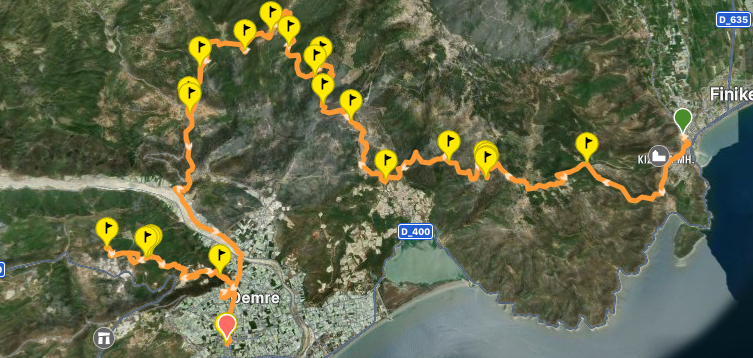
The St. Nicholas Path, which is highly appreciated by travelers for its marked trails and maps, is one of the most interesting routes, especially after the St. Paul Trail, due to the historical sites it passes through and the beautiful landscapes along the way.
The St. Nicholas Path was developed with the collaboration of the Demre and Beymelek municipalities and the support of BAKA to reduce rural migration to cities. This route covers approximately 100 kilometers, including the travels of St. Nicholas.
Before describing the route, let’s take a moment to discuss who St. Nicholas is and why he holds such significance in this region. St. Nicholas was born in Patara, the port city of Lycia, into a wealthy family. After losing his parents at a young age, he was raised by his uncle. St. Nicholas distributed his family’s wealth to the elderly, the needy, and those in need of help. Due to his many miracles, he is widely known as “The Miracle Worker” among the people. Even today, miracles related to him are still told in the region. St. Nicholas is also known as Santa Claus or Father Christmas. His tomb is located in the church cemetery in Myra.
The St. Nicholas Path is a challenging and enjoyable route that spans between Kaş, Demre, and Finike, including 11 ancient cities in the peaks of the Taurus Mountains. Some sections of the trail continue along the Lycian Way, marked with blue and white colors, while the Lycian Way itself is marked with red and white colors. Due to many ascents and descents, it is important to carry plenty of water with you. There won’t be many settlements along the way, and you will mostly encounter shepherds. The most beautiful view is from the ancient city of Phellos, overlooking the Demre Plain and the sunset.
Once you reach Beymelek village, you will witness the efforts and promotional activities for the region. Houses built in accordance with local architecture and restored historical buildings will make you forget the challenging parts of the route. At the Ision Tower in Beymelek, you can clearly see the rock-carved pools that were used in ancient times for processing olives and extracting olive oil.
As we know, olive oil was the most valuable treasure in those times. Historical records show that olives have been cultivated and olive oil has been traded on the Aegean and Mediterranean coasts since around 4500 BC. Olive oil was used in soap-making, cooking, medicine, and as fuel.
Guests staying at Belconti Resort Hotel in Belek, Antalya, and looking to experience something different can join the numerous nature walking groups organized on weekends and enjoy these extraordinary routes with breathtaking beauty.







